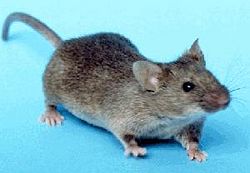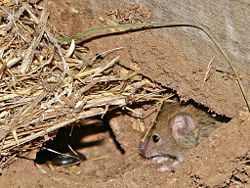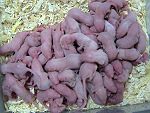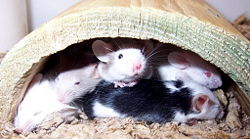Difference between revisions of "Mouse" - New World Encyclopedia
| Line 47: | Line 47: | ||
Mice are the most commonly utilized animal research model with hundreds of established inbred, outbred, and transgenic strains. In the United States, they are not covered under the Animal Welfare Act (AWA) (administered by the United States Department of Agriculture (USDA), Animal and Plant Health Inspection Service (APHIS)) as an animal. However, the Public Health Service Act (PHS)<ref name=Public_Health_Service_Act>{{cite web | url = http://grants.nih.gov/grants/olaw/references/phspol.htm | title = Public Health Service Act}}</ref> as administered by the National Institute of Health (NIH) does cover their humane treatment. | Mice are the most commonly utilized animal research model with hundreds of established inbred, outbred, and transgenic strains. In the United States, they are not covered under the Animal Welfare Act (AWA) (administered by the United States Department of Agriculture (USDA), Animal and Plant Health Inspection Service (APHIS)) as an animal. However, the Public Health Service Act (PHS)<ref name=Public_Health_Service_Act>{{cite web | url = http://grants.nih.gov/grants/olaw/references/phspol.htm | title = Public Health Service Act}}</ref> as administered by the National Institute of Health (NIH) does cover their humane treatment. | ||
| − | Mice are common experimental animals in [[biology]] and [[psychology]] primarily because they are mammals, and thus | + | Mice are common experimental animals in [[biology]] and [[psychology]] primarily because they are mammals, and thus are biologically very similar to humans, but can be manipulated in ways that would be considered unethical with humans and larger mammals. |
| − | Additional benefits of mice in laboratory research include the fact that mice are small, inexpensive, and several generations can be observed in a relatively short period of time. The mouse genome has been sequenced, and virtually all mouse genes have human homologs. | + | Additional benefits of mice in laboratory research include the fact that mice are small, inexpensive, and several generations can be observed in a relatively short period of time. The mouse genome has been sequenced, and virtually all mouse genes have human homologs. (A homolog is a gene that is related to a second gene by common evolutionary ancestry.) |
==Mice as feeder animals== | ==Mice as feeder animals== | ||
[[Image:Feeder_mice.jpg|150px|thumb|"Pinkie" mice for sale as reptile food.]] | [[Image:Feeder_mice.jpg|150px|thumb|"Pinkie" mice for sale as reptile food.]] | ||
| − | A very common use of mice is to feed many species of [[snakes]], [[lizards]], and even [[tarantulas]]. Most | + | A very common use of mice is to feed many species of [[snakes]], [[lizards]], and even [[tarantulas]]. Most U.S. pet stores now carry mice for this purpose. Mice are ideal to sell for consumption by animals of many different sizes, as they breed quickly, grow quickly, are easy to care for, and can be sold in a wide variety of sizes. Common terms used to refer to different ages and sizes of mice are pinkies, fuzzies, hoppers, and adults. Pinkies are newborn mice that have not yet grown fur. Fuzzies have some fur but are generally not very mobile. Hoppers have a full coat of hair and are fully mobile but are smaller than adult mice. These terms also refer to the various growth stages of [[rat]]s. |
Mice specifically bred for pets and feeders are sometimes called fancy mice. | Mice specifically bred for pets and feeders are sometimes called fancy mice. | ||
| Line 63: | Line 63: | ||
*Cage- Usually a hamster or gerbil cage, but specific mouse cages are also now available. | *Cage- Usually a hamster or gerbil cage, but specific mouse cages are also now available. | ||
*Food- Special pelleted and seed-based food is available. | *Food- Special pelleted and seed-based food is available. | ||
| − | *Bedding- Usually hardwoods, such as aspen. Cedar or pine should not be used because they contain harmful liquids that can damage any rodent's respiratory system. Corn cob bedding should also not be used because it promotes ''Aspergillis Fungus'' growth and allows mold growth once it gets wet. It also is quite rough on mouse feet. Recycled virgin wood pulp is also used. | + | *Bedding- Usually hardwoods, such as aspen. Cedar or pine should not be used because they contain harmful liquids that can damage any rodent's respiratory system. Corn-cob bedding should also not be used because it promotes ''Aspergillis Fungus'' growth and allows mold growth once it gets wet. It also is quite rough on mouse feet. Recycled virgin wood pulp is also used. |
Some benefits of having mice as pets include the following: | Some benefits of having mice as pets include the following: | ||
| Line 69: | Line 69: | ||
*Mice are entertaining and affectionate, | *Mice are entertaining and affectionate, | ||
*Mice are inexpensive, | *Mice are inexpensive, | ||
| − | *Mice are | + | *Mice are clean (contrary to popular belief), |
*Mice are socially self-sufficient (when in a group of other mice), | *Mice are socially self-sufficient (when in a group of other mice), | ||
*Mice are significantly less likely to bite than other rodent pets, | *Mice are significantly less likely to bite than other rodent pets, | ||
Revision as of 22:12, 10 January 2007
| Mouse Fossil Range: Late Miocene - Recent | ||||||||||||||||
|---|---|---|---|---|---|---|---|---|---|---|---|---|---|---|---|---|
 House mouse, Mus musculus | ||||||||||||||||
| Scientific classification | ||||||||||||||||
|
There is some disagreement over what range of animals is encompassed by the term mouse (plural mice). In Webster's Third New International Dictionary, a mouse is defined as "any of numerous small rodents typically resembling diminutive rats with pointed snout, rather small ears, elongated body and slender hairless or sparsely haired tail, including all the small members of the genus Mus and many members of other rodent genera and families having little more in common than their relatively small size." However, the order Rodentia (in the kingdom Animalia, phylum Chordata, and subphylum Vertebrata) contains a wide range of families, many of which contain some animals that may be referred to as mice. The family Muridae itself contains over one thousand different species, including voles, gerbils and rats. There are some definitions (such as the Oxford English Dictionary definition) of mouse that assert that any animal in the family Muridae is a mouse. Within the Muridae family is the subfamily Murinae, and within this subfamily is the genus Mus. Some definitions (such as the Merriam-Webster online definition) define a "mouse" as a member of the genus Mus. The remainder of this article will assume a mouse to be any animal within the genus Mus unless otherwise stated.
The best known mouse species is the common house mouse (Mus musculus). It is found in nearly all countries and, as the laboratory mouse, serves as an important model organism in biology, and is also a popular pet. The American white-footed mouse (Peromyscus leucopus) and the deer mouse (Peromyscus maniculatus) also sometimes live in houses (though they are not included in the 'house mouse' category, nor are they included in the genus Mus). These species of mice generally live commensally with humans (that is, they benefit from humans without affecting humans either positively or negatively).
Although they may live up to two years in the lab, the average mouse in the wild lives only about three months, primarily due to heavy predation. Cats, wild dogs, foxes, birds of prey, snakes and even certain kinds of insects have been known to prey heavily upon mice. Nevertheless, due to its incredible adaptability to almost any environment and its general ability to live commensally with humans, it is regarded to be the second most successful mammalian species living on earth today (the first being the rat).
In some ways, mice can be harmful pests, damaging and eating crops and spreading diseases through their parasites and feces. In the Western U.S., breathing dust which has come in contact with mouse feces has been linked to the deadly (though rare) Hantavirus. The original motivation for the domestication of cats is thought to have been for their predation of mice and their relatives, the rats.
Body and behavior
Mice are small rodents, resembling diminutive rats. Usually, they have pointed snouts, small ears, elongated bodies, and slender, hairless tails. However, different types of mice show large variations in physical features, and body dimensions especially vary considerably by species. The following are approximate values of physical features of an average mouse: a total body length of 28-130 mm and body mass of 2.5 to >34g[1].
Mice generally live on a herbivorous diet, but are actually omnivores, as they will at times eat meat, such as the dead bodies of other mice. They have also been observed to self-cannibalize their tails during starvation. Grasshopper mice are an exception to the rule, being the only fully carnivorous mice. On average, mice eat grains, fruits, and seeds for a regular diet, hence their reputation for damaging crops. They are also known to eat their own droppings on rare occasions.
Mice are social animals, preferring to live in groups. Male rivalry can become harmful for the animal, especially when confined to a small space. The natural habitats of the mouse are very diverse. Mice can be found in forests, savannahs, grasslands and rocky habitats [1]. In Africa they tend to particularly like forest edge, derived savannah, and agricultural areas. Mice build nests for protection and warmth, though different species have varying preferences: M. minutoides nest in shallow burrows, M. caroli and M. cervicolor burrow, while M. shortridgei and M. pahari nest above ground. Most species will construct nests of grass, fibers, and shredded material [1]. Mice do not hibernate.
The mouse has bichromatic vision, meaning it has two instead of three retinal photopigments tuned to peak wavelengths, or colors. It lacks a photopigment for the detection of red light.[2]
History
Mouse-like species are among the oldest mammals. It has been proposed that higher mammals evolved from rodent-like species many millions of years ago.
Mice have been known to humans since antiquity. The Romans differentiated poorly between mice and rats, calling rats Mus Maximus (big mouse) and referring to mice as Mus Minimus (little mouse). In Spanish similar terms are in use: ratón for mouse and rata for rat [1].
Discoloration in mice was supposedly first noticed in China by 1100 B.C.E., where a white mouse was discovered. However, there is sufficient evidence to believe that white mice were first noticed before that, in the times of the Greeks and Ancient Rome.
The word "mouse" and the word muscle are related. Muscle stems from musculus meaning small mouse - possibly because of a similarity in shape [2] [3]. The word "mouse" is cognate with Sanskrit mush meaning 'to steal' which is also cognate with mys in Old Greek and mus in Latin [4].
Laboratory mice
Mice are the most commonly utilized animal research model with hundreds of established inbred, outbred, and transgenic strains. In the United States, they are not covered under the Animal Welfare Act (AWA) (administered by the United States Department of Agriculture (USDA), Animal and Plant Health Inspection Service (APHIS)) as an animal. However, the Public Health Service Act (PHS)[3] as administered by the National Institute of Health (NIH) does cover their humane treatment.
Mice are common experimental animals in biology and psychology primarily because they are mammals, and thus are biologically very similar to humans, but can be manipulated in ways that would be considered unethical with humans and larger mammals.
Additional benefits of mice in laboratory research include the fact that mice are small, inexpensive, and several generations can be observed in a relatively short period of time. The mouse genome has been sequenced, and virtually all mouse genes have human homologs. (A homolog is a gene that is related to a second gene by common evolutionary ancestry.)
Mice as feeder animals
A very common use of mice is to feed many species of snakes, lizards, and even tarantulas. Most U.S. pet stores now carry mice for this purpose. Mice are ideal to sell for consumption by animals of many different sizes, as they breed quickly, grow quickly, are easy to care for, and can be sold in a wide variety of sizes. Common terms used to refer to different ages and sizes of mice are pinkies, fuzzies, hoppers, and adults. Pinkies are newborn mice that have not yet grown fur. Fuzzies have some fur but are generally not very mobile. Hoppers have a full coat of hair and are fully mobile but are smaller than adult mice. These terms also refer to the various growth stages of rats.
Mice specifically bred for pets and feeders are sometimes called fancy mice.
Mice as pets
- Main article: Fancy mouse
Mice are now one of the leading rodent pets. Although their main purpose in pet stores is to be sold as snake food, many people buy mice as companion pets. Some common pet-mouse products used are:
- Cage- Usually a hamster or gerbil cage, but specific mouse cages are also now available.
- Food- Special pelleted and seed-based food is available.
- Bedding- Usually hardwoods, such as aspen. Cedar or pine should not be used because they contain harmful liquids that can damage any rodent's respiratory system. Corn-cob bedding should also not be used because it promotes Aspergillis Fungus growth and allows mold growth once it gets wet. It also is quite rough on mouse feet. Recycled virgin wood pulp is also used.
Some benefits of having mice as pets include the following:
- Mice give minimal shedding and allergens,
- Mice are entertaining and affectionate,
- Mice are inexpensive,
- Mice are clean (contrary to popular belief),
- Mice are socially self-sufficient (when in a group of other mice),
- Mice are significantly less likely to bite than other rodent pets,
- Mice are quite intelligent given their size.
There are, however, some disadvantages to having pet mice:
- Mice are small and quite fragile (not as easy to handle as a dog or a cat),
- Mice are nocturnal,
- Mice have frequent eye infections,
- Mice are easily subject to disease when without optimal care,
- Mice reproduce frequently,
- Mice have a short lifespan.
Mice in popular culture
- Main article: Mice in fiction
- In Of Mice and Men, the novel by John Steinbeck, the character Lennie has a particular fascination with mice.
- The cartoons Danger Mouse and Mighty Mouse also depict mice with high regard.
- The smartest organisms in the universe in The Hitchhikers Guide to the Galaxy are mice.
- One of the two heroes in a popular cartoon Tom and Jerry is a mouse named Jerry, who is portrayed as engaging in perpetual, yet sometimes friendly, combat with the other hero, a cat named Tom.
- The main characters in a cartoon called Pinky and the Brain are mice.
- The widely known Mickey Mouse is the spokesman of Disney.
- The famous Geronimo Stilton is the protagonist of the eponymous book series.
- Mice are portrayed as heroes and have human-like characteristics in the book series Redwall.
- All of the Jews in Maus, a graphic novel about the Holocaust, are depicted as mice.
- The Cartoon Speedy Gonzalez is a mouse.
- Edward Delacroix trains a mouse who lives to be well over sixty years old in The Green Mile.
Taxonomy of the genus Mus
The term "mouse" in common usage is often considered to be equivalent to the taxonomic term Mus, while house mouse is equivalent to Mus musculus. In common language the term "mouse" often refers incorrectly to Mus musculus. There are 38 species of mice in the genus Mus, as shown in the following table.
| Genus Mus | |||||||
|---|---|---|---|---|---|---|---|
| Subgenus Pyromys | Subgenus Coelomys | Subgenus Mus | Subgenus Nannomys | ||||
|
|
|
|
|
|
|
|
ReferencesISBN links support NWE through referral fees
- ↑ 1.0 1.1 1.2 Nowak, Ronald M. 1999. Walker's Mammals of the World, 6th edition. Johns Hopkins University Press, 1936 pp. ISBN 0-8018-5789-9
- ↑ Jacobs GH, Williams GA, Fenwick JA. Influence of cone pigment co-expression on spectral sensitivity and color vision in the mouse. Vision Res. 2004; 44(14):1615-22
- ↑ Public Health Service Act.
External links
- Impact of Mice on endangered species
- High-Resolution Images of the Mouse Brain
- E. Eisen chapter 1: history of the mouse
- Discoloration in mice; The history of mice
- Rat@Genesh 'Ganesh rides a Mouse'
Mice as pets
- Fancy Mice 'A complete resource for pet owners and show breeders'
- PetCo (see care sheets for pet mouse information)
- Mice at PetWebSite
- Mice fansite
- Mice fanlisting
- Mice as pets
Credits
New World Encyclopedia writers and editors rewrote and completed the Wikipedia article in accordance with New World Encyclopedia standards. This article abides by terms of the Creative Commons CC-by-sa 3.0 License (CC-by-sa), which may be used and disseminated with proper attribution. Credit is due under the terms of this license that can reference both the New World Encyclopedia contributors and the selfless volunteer contributors of the Wikimedia Foundation. To cite this article click here for a list of acceptable citing formats.The history of earlier contributions by wikipedians is accessible to researchers here:
The history of this article since it was imported to New World Encyclopedia:
Note: Some restrictions may apply to use of individual images which are separately licensed.


